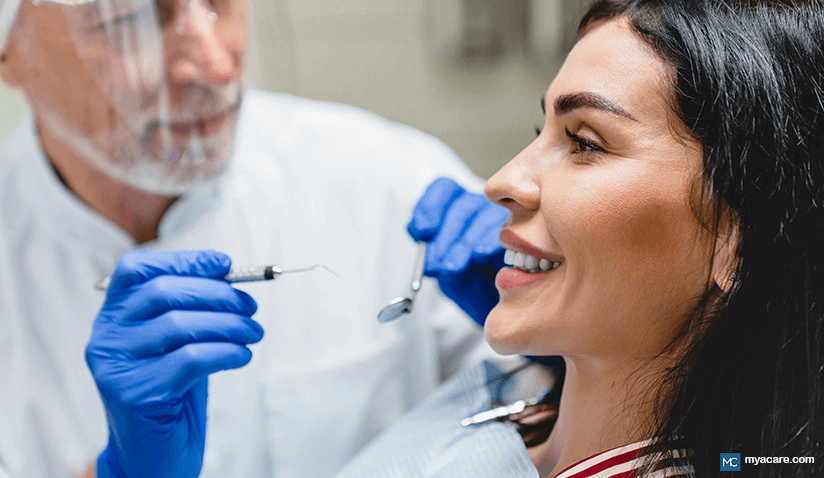Laser Dentistry: Benefits and Risks Involved

Lasers have become the new normal for many surgical procedures (e.g., vision correction, plastic surgery, and removal of tumors and kidney stones). In dentistry, lasers are primarily used for cutting or reshaping tissues in the oral cavity. With the advent of office-based, portable, and easy-to-use lasers, lasers have become a popular feature in dental clinics. Patients increasingly opt for laser-assisted treatments as they are less painful than traditional techniques (involving scalpel). However, their use in dentistry is also prone to risks.
In this article, we discuss the types of dental lasers, their application in dentistry, their benefits, and the risks involved in their use.
Working of Dental Lasers
LASER stands for ‘Light Amplification by the Stimulated Emission of Radiation.’ Laser light is monochromatic and consists of a single wavelength of light. The dental laser delivers light from the machine to the target tissues (soft or hard tissue) in the oral cavity. The laser light increases the temperature of tissues, enabling the removal or modification of target tissues. The temperature can be modulated to achieve the desired effect. Besides cutting and shaping tissues, lasers have several other applications:
- The laser aids in killing disease-causing bacteria. So, lasers are used to disinfect root canals, diseased gums (periodontal pockets), and sites with inflammation around dental implants (peri-implantitis).
- Lasers are used to detect decay in teeth. This is achieved by studying the differences in light-emitting properties of decayed and healthy teeth.
- At low intensities, the laser stimulates the proliferation of certain cells (e.g., fibroblasts) that enhance wound healing.
- In the teeth whitening process, the laser light helps stimulate the teeth whitening solution, accelerating the process.
Types of Dental Lasers
Dental lasers are classified as:
- Hard tissue laser: This type of laser can be used on the hard tissues (e.g., teeth and bone), as well as soft tissues (gums, mucosa, or inner skin of mouth) in the oral cavity. Hard tissue lasers are expensive, and pose a high risk of injury to tooth pulp due to excess heat produced. Examples of such lasers are the carbon dioxide laser and Neodymium Yttrium Aluminum Garnet laser.
- Soft tissue laser: This type of laser can be used only on soft tissues present in the oral cavity (e.g., gums, mucosa, or inner skin of mouth). Despite their limited application, soft tissue lasers are preferred in dental offices due to their compact size, low cost, and wide range of applications. An example of this type of laser is the diode laser.
Application of Lasers in Dentistry
The use of laser in dentistry was introduced in the 1960s, and its usage in treating gums was approved by the US Food and Drug Administration in the 1990s. Below are some of the uses of lasers in dentistry:
Uses in soft tissues (e.g., gums or inner skin of mouth)
- Reshaping of gums for better appearance
- Removal of benign tissue overgrowths in the gums
- Treatment of gum diseases (periodontitis)
- Removing soft tissue from partially-erupted teeth (impacted teeth)
- Removal of soft tissues to expose dental implants for prosthetic rehabilitation
- Promoting better wound healing
- Treatment of tongue-tie (soft tissue fold connecting front part of the tongue with floor of the mouth)
- Treatment of cold sores or ulcers (e.g., herpetic sores induced by a virus)
- Reducing pain and inflammation on temporomandibular joint (movable joint connecting the lower jaw with the head)
- Removal of soft tissue for biopsy of lesions
Uses in hard tissues (teeth and bone)
- Removal of decay from the cavity
- Removal of filling materials
- Detection of tooth decay
- Treatment of teeth sensitivity
- Whitening of teeth
Benefits of Using the Laser in Dentistry
Below are some advantages of using lasers in dentistry:
- Faster and comfortable healing of the operated site
- Less post-operative bleeding
- Minimal pain after the procedure
- Reduced swelling
- Minimal damage to adjacent tissues
- Reduced risk of infection
- Better visibility of the operative site during the treatment (as laser arrests bleeding)
- A better experience with reduced noise of the drills
- Reduced chairside time
- Reduced need for sutures
- Sterilized cavity preparations
- Stronger fillings with better bonding and adaptation to margins of tooth surface
- Bactericidal effects
Risks Involved With the Use of Lasers in Dentistry
Although the use of lasers is considered safe in dentistry, certain risks are involved if enough precautions are not taken. Below are some of the risks involved:
- Risk to eyes: Most of the lasers can injure or damage eyes. The direct interaction of laser light with naked eyes causes burns in the structures of the eyes. This results in scarring and distortion of vision.
- Risk to skin: In rare cases, due to a high concentration of optical power, lasers can cause skin burns.
- Risk of damage to other tooth structures: Improper irradiation of laser on teeth and diseased gums can damage the dental pulp (innermost layer of the tooth) and underlying tooth-supporting bone.
- Inhalation of laser plume: When laser light is applied to tissues, a chemical mixture is emitted, known as laser plume. The laser plume comprises harmful carbon monoxide, carbon dioxide, and organic materials. The inhalation of these materials can cause nausea and breathing difficulties.
Precautions
Below are some of the precautions that must be taken while using lasers to reduce the risk of injuries to other structures:
- Patients, operators, and assistants should wear appropriate eyewear to protect eyes.
- The patient’s throat and other non-target sites in the mouth should be protected.
- High-speed suction pipes or evacuation should be used to absorb laser plumes.
- Laser light should not be focused on shiny metal surfaces as light may reflect back and cause damage.
- The heat generated during the procedure can be minimized with the use of water spray.
- The laser should be in good working condition.
- Foot pedal control should be accurate.
- The laser should be maintained as per the manufacturer's instructions.
As in other surgical procedures, the use of laser in dentistry is here to stay. A wide range of applications and significant benefits over traditional methods makes laser the tool of choice for many procedures. Patients and dentists must ensure that safety precautions are taken to avoid any accident.
To search for the best dentists in India, Malaysia, Singapore, Spain, Thailand, Turkey, the UAE, UK and the USA, please use the Mya Care search engine.

Dr. Shilpy Bhandari is an experienced dental surgeon, with specialization in periodontics and implantology. She received her graduate and postgraduate education from Rajiv Gandhi University of Health Sciences in India. Besides her private practice, she enjoys writing on medical topics. She is also interested in evidence-based academic writing and has published several articles in international journals.
References:
Featured Blogs



